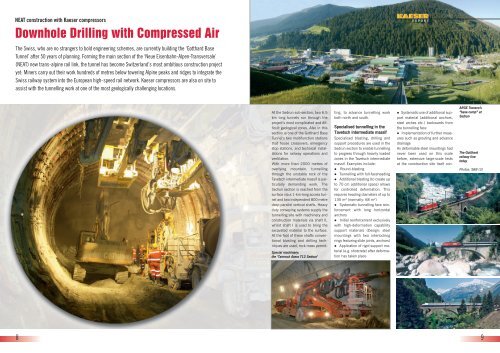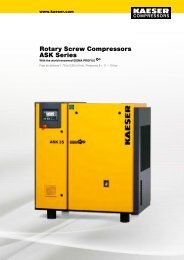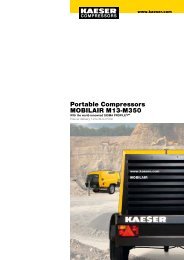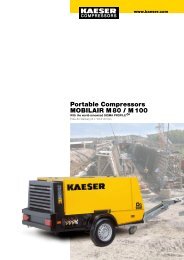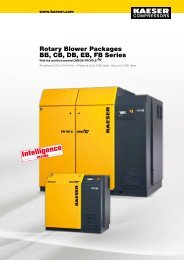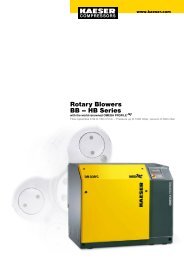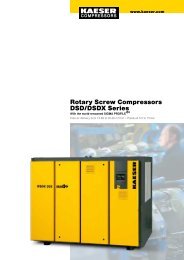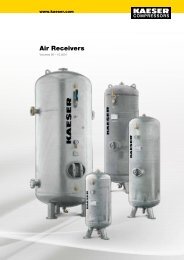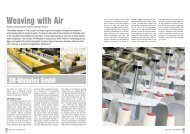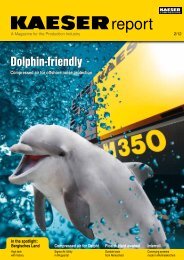Downhole Drilling with Compressed Air - Kaeser Compressors
Downhole Drilling with Compressed Air - Kaeser Compressors
Downhole Drilling with Compressed Air - Kaeser Compressors
Create successful ePaper yourself
Turn your PDF publications into a flip-book with our unique Google optimized e-Paper software.
NEAT construction <strong>with</strong> <strong>Kaeser</strong> compressors<br />
<strong>Downhole</strong> <strong>Drilling</strong> <strong>with</strong> <strong>Compressed</strong> <strong>Air</strong><br />
The Swiss, who are no strangers to bold engineering schemes, are currently building the ‘Gotthard Base<br />
Tunnel’ after 50 years of planning. Forming the main section of the ‘Neue Eisenbahn-Alpen-Transversale’<br />
(NEAT) new trans-alpine rail link, the tunnel has become Switzerland’s most ambitious construction project<br />
yet: Miners carry out their work hundreds of metres below towering Alpine peaks and ridges to integrate the<br />
Swiss railway system into the European high-speed rail network. <strong>Kaeser</strong> compressors are also on site to<br />
assist <strong>with</strong> the tunnelling work at one of the most geologically challenging locations.<br />
8<br />
At the Sedrun sub-section, two 6.5<br />
km long tunnels run through the<br />
project’s most complicated and difficult<br />
geological zones. Also in this<br />
section is one of the Gotthard Base<br />
Tunnel’s two multifunction stations<br />
that house crossovers, emergency<br />
stop stations, and technical installations<br />
for railway operations and<br />
ventilation.<br />
With more than 2000 metres of<br />
overlying mountain, tunnelling<br />
through the unstable rock of the<br />
Tavetsch intermediate massif is particularly<br />
demanding work. The<br />
Sedrun section is reached from the<br />
surface via a 1-km-long access tunnel<br />
and two independent 800 metre<br />
deep parallel vertical shafts. Heavy<br />
duty conveying systems supply the<br />
tunnelling site <strong>with</strong> machinery and<br />
construction materials via shaft II,<br />
whilst shaft I is used to bring the<br />
excavated material to the surface.<br />
At the foot of these shafts conventional<br />
blasting and drilling techniques<br />
are used, rock mass permit-<br />
Special machinery:<br />
the ‘Tamrock Axera T12 Sedrun’<br />
ting, to advance tunnelling work<br />
both north and south.<br />
Specialised tunnelling in the<br />
Tavetsch intermediate massif<br />
Specialised blasting, drilling and<br />
support procedures are used in the<br />
Sedrun section to enable tunnelling<br />
to progress through heavily loaded<br />
zones in the Tavetsch intermediate<br />
massif. Examples include:<br />
� Round-blasting<br />
� Tunnelling <strong>with</strong> full-faceheading<br />
� Additional blasting (to create up<br />
to 70 cm additional space) allows<br />
for controlled deformation. This<br />
requires heading diameters of up to<br />
135 m² (normally: 68 m²)<br />
� Systematic tunnelling face reinforcement<br />
<strong>with</strong> long horizontal<br />
anchors<br />
� Initial reinforcement exclusively<br />
<strong>with</strong> high-deformation capability<br />
support materials (Design: steel<br />
mountings <strong>with</strong> two interlocking<br />
rings featuring slide joints, anchors)<br />
� Application of rigid support material<br />
(e.g. shotcrete) after deformation<br />
has taken place<br />
� Systematic use of additional support<br />
material (additional anchors,<br />
steel arches etc.) backwards from<br />
the tunnelling face<br />
� Implementation of further measures<br />
such as grouting and advance<br />
drainage<br />
As deformable steel mountings had<br />
never been used on this scale<br />
before, extensive large-scale tests<br />
at the construction site itself con-<br />
ARGE Transco’s<br />
“base camp” at<br />
Sedrun<br />
The Gotthard<br />
railway line<br />
today<br />
Photos: SBB (3)<br />
9
A complete<br />
tunnel system<br />
takes shape<br />
deep <strong>with</strong>in the<br />
mountain<br />
Excavated<br />
material is<br />
carried to the<br />
shaft via rail<br />
10<br />
firmed that the theory worked in<br />
practice.<br />
To maximise the narrow workspace,<br />
ARGE TRANSCO-Sedrun installed a<br />
multi-functional heading installation<br />
that is suspended from the tunnel<br />
roof on a monorail system. In<br />
use for the first time in tunnel construction<br />
and more usually associated<br />
<strong>with</strong> mining, the four multifunctional<br />
machines create a second<br />
work level for the placing of<br />
steel arches, cutting of anchors at<br />
the tunnelling face and also for<br />
application of shotcrete at the tunnelling<br />
face.<br />
Special machines,<br />
special service<br />
Construction machinery supplier<br />
Avesco AG, the representative for<br />
Caterpillar and Sandvik-Tamrock in<br />
Langenthal, was awarded the contract<br />
to supply ten ‘Tamrock-Axera’<br />
drilling jumbos, seven ‘Tamrock-<br />
Toro’ front-loaders, four ‘Caterpillar’<br />
special excavators, twelve ‘Rammer’<br />
hydraulic hammers, as well as<br />
‘Sandvik’ drilling steels. Avesco is<br />
also responsible for supervision of<br />
tunnelling equipment at the con-<br />
struction site. Avesco Service Technicians<br />
are permanently on-site and<br />
work in three shifts, seven days a<br />
week to provide round-the-clock<br />
support for the machinery. Furthermore,<br />
a spare parts and a drillingsteel<br />
store are located underground,<br />
as is an office container equipped<br />
<strong>with</strong> its own IT infrastructure.<br />
<strong>Drilling</strong> <strong>with</strong> air-power<br />
A working group of representatives<br />
from Arge Transco Sedrun, Avesco<br />
Langenthal and Tamrock (Finland)<br />
developed a special drilling installation<br />
that would be able to tunnel<br />
through the pressure zones of the<br />
Tavetsch intermediate massif.<br />
Weighing in at over 60 tonnes, the<br />
giant ‘Tamrock Axera T12 Sedrun’<br />
can sweep across the entire 13metre<br />
tunnel diameter <strong>with</strong> its<br />
drilling arms to set blast holes, selfdrilling<br />
anchors, as well as cased<br />
anchors, up to a drill diameter of<br />
140 mm. For cased anchors, the<br />
machines use the downhole drilling<br />
method: Hydraulically driven via<br />
push rods, the rotating drill-bit is<br />
equipped <strong>with</strong> a pneumatically<br />
powered hammer drill, which <strong>with</strong>in<br />
this diameter range, significantly<br />
increases overall system efficiency.<br />
Furthermore, it eases the burden on<br />
the hydraulic drive system & bore<br />
rods, enables precision drilling at<br />
The compressed air for the ‘downhole<br />
drilling’ process is produced here<br />
low push rod speeds (10 to 60 rpm)<br />
and simplifies setting of linear boreholes.<br />
At the same time, the compressed<br />
air used to power the downhole<br />
drill-hammer also removes the drill<br />
dust from the borehole and adding<br />
dust-binding foam to the compressed<br />
air prevents dust build-up.<br />
<strong>Downhole</strong> drilling is a relatively new<br />
process suited to large drilling<br />
diameters and has proven particularly<br />
effective both in extremely<br />
hard and in soft rock masses.<br />
<strong>Compressed</strong> air for the drill-bit<br />
<strong>Kaeser</strong> rotary screw compressors<br />
mounted on tunnel railcars provide<br />
the compressed air that powers the<br />
downhole drilling equipment at the<br />
Sedrun construction site. This system<br />
enables efficient compressed<br />
air delivery exactly where it is needed,<br />
as the air does not have to pass<br />
through long sections of piping.<br />
Each compressed air car is<br />
equipped <strong>with</strong> two <strong>Kaeser</strong> CSDX<br />
162 rotary screw compressors and<br />
a 3000-litre air receiver per compressor.<br />
Most of the condensate<br />
that occurs during the compression<br />
process is removed via centrifugal<br />
Photo: SBB/AlpTransit Gotthard AG<br />
Sedrun Section – Facts and Figures<br />
· Two tunnels approx. 6.5 km long <strong>with</strong> 50 m<br />
separation<br />
· Connecting galleries every 320 m<br />
· Multifunction station <strong>with</strong> two emergency stops<br />
· Total length of tunnelling approx. 20 km<br />
· Cost: 1.25 billion CHF<br />
· Workforce: up to 450 employees<br />
· Installation work: May 2002 to October 2003<br />
· Shaft II construction: May 2003 to February<br />
2004<br />
· Tunnel blasting begins: July 2003 (North side),<br />
August 2004 (South side)<br />
· Estimated breakthrough: Summer 2008 (North<br />
side), Autumn 2008 (South side)<br />
· Completion of blasting: End 2008<br />
· Concreting and finishing: 2006 to 2009<br />
· Handover to owners: Summer 2011<br />
separator, whilst ‘Eco Drain’ condensate<br />
drains ensure ecologically<br />
sound disposal. For equipment to<br />
operate reliably and efficiently in<br />
such a hostile working environment,<br />
meticulous design and construction<br />
are essential. <strong>Kaeser</strong> compressors,<br />
for example, feature large<br />
low-speed airends filled <strong>with</strong> generous<br />
volumes of cooling / lubricating<br />
fluid to ensure effective removal of<br />
particles from the intake air.<br />
As a result, <strong>Kaeser</strong> compressors<br />
provide far superior performance<br />
and reliability compared <strong>with</strong> units<br />
equipped <strong>with</strong> smaller high-speed<br />
airends. This advantage is further<br />
enhanced by <strong>Kaeser</strong>’s use of a<br />
maintenance-free 1:1 direct drive<br />
coupling to turn the airend, as this<br />
eliminates the power losses associated<br />
<strong>with</strong> gear driven systems.<br />
With unrivalled quality and dependability,<br />
<strong>Kaeser</strong> compressors are in<br />
their element performing such a<br />
demanding role at what is one of<br />
the world’s most challenging construction<br />
sites.<br />
Author: Klaus Dieter Bätz<br />
Contact: klaus-dieter.baetz@kaeser.com<br />
11


